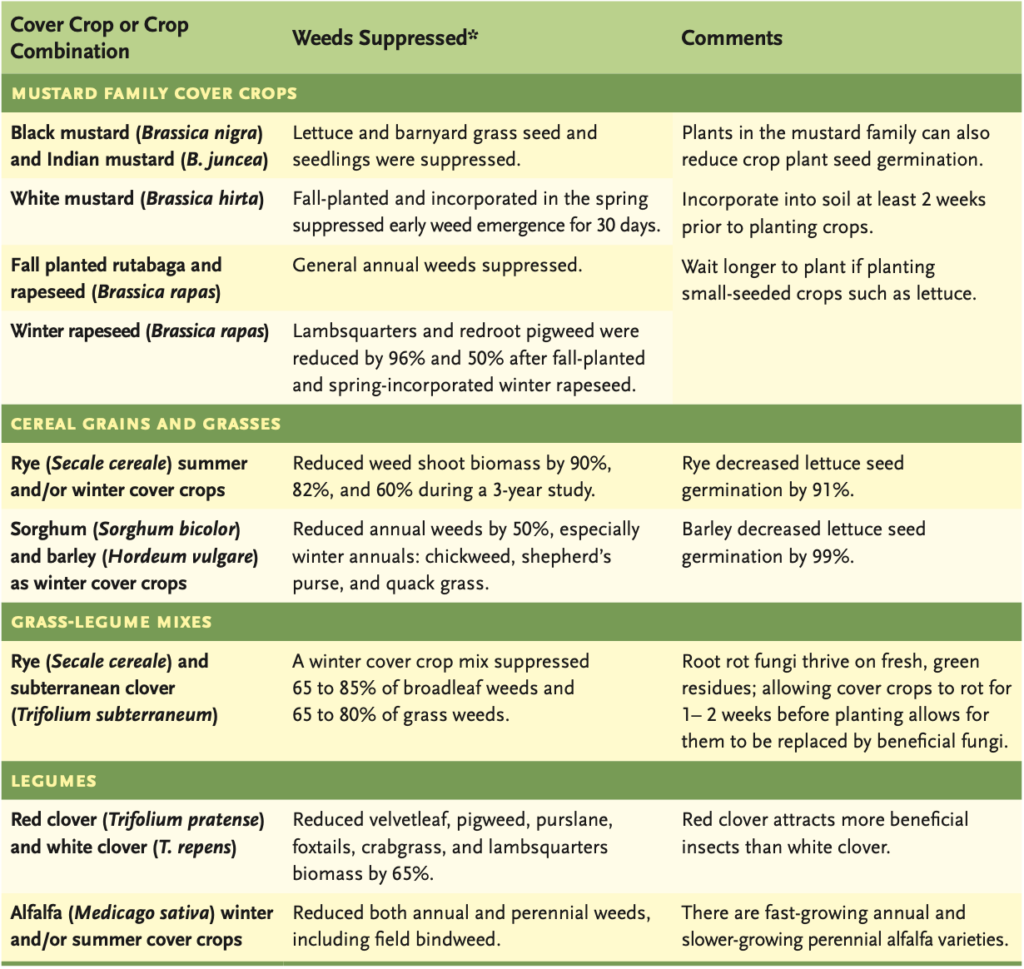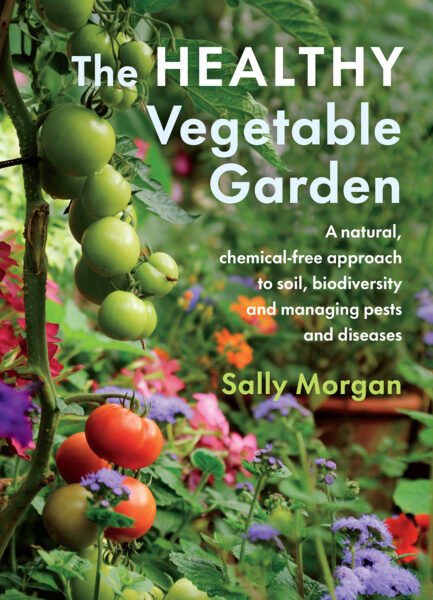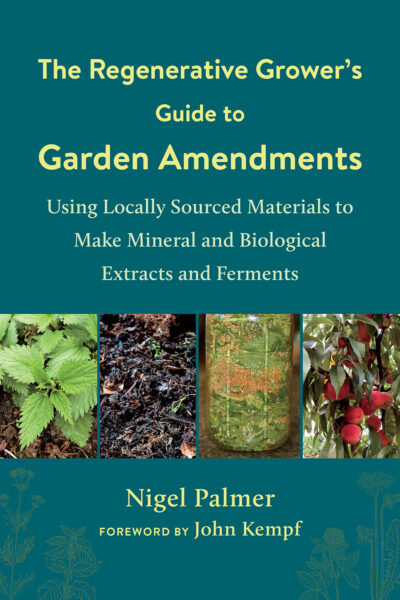Weed Suppression: Choosing The Right Cover Crops & Living Mulches
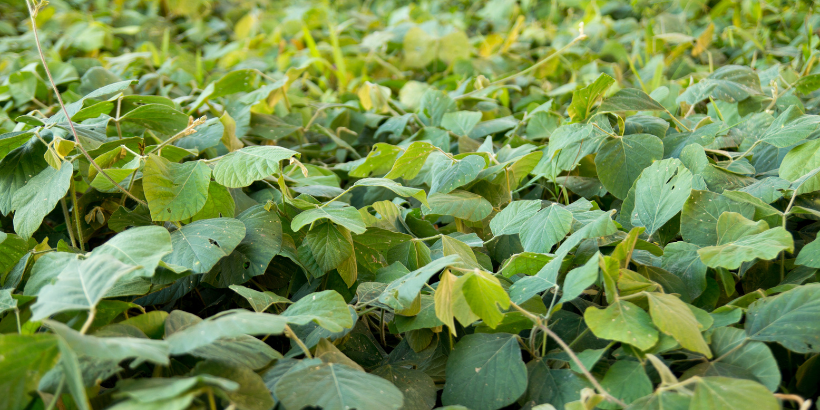
Trying to figure out how to manage weeds in your garden beds? Use cover crops and living mulches for weed suppression while your garden flourishes!
The following is an excerpt from The Ecological Farm by Helen Atthowe. It has been adapted for the web.
Suppressing Weeds With Cover Crops: Getting Started
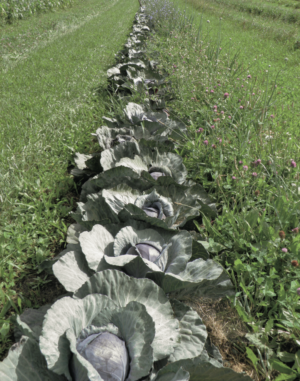
Figure 8.5. Blooming red clover “weeds” moving from living mulch row middles into maturing onions and red cabbage in late summer at Woodleaf Farm, Oregon.
Cover crops suppress weeds via several mechanisms that often interact and affect more than one ecological function at a time.
Common weed suppression mechanisms include resource and light competition, interference with weed life cycles, physical suppression by cover crop residues, release of phytotoxic biochemicals, and encouraging soil microorganisms to suppress weed growth and reproduction.
Shading and Smothering Weeds
Cover crops can shade out weed species that require light for germination. They also compete directly with weeds for nutrients and water as they develop extensive canopies and deep root systems, so that weeds don’t have the resources to invade.
Combinations of grasses and legumes provide thick cover crop canopies that decrease the light cues needed for weed seed germination. Sowing at an especially heavy rate can also have a smothering effect.
Which Cover Crops Are Best For Weed Suppression?
Various cover crops have been shown to suppress specific weeds when managed in specific ways. For example, in one study the greater the amount of red clover biomass incorporated into the soil, the more early-season suppression of wild mustard occurred and the higher the sweet corn yield.14
An incorporated crimson clover cover crop decreased lambsquarters biomass by 65 percent and increased sweet corn yield by 131 percent.15
Using another legume, alfalfa, as a cover crop or in a crop rotation has reduced populations of both annual and perennial weeds. Clover and alfalfa are great for suppressing weeds when planted as a cover crop and tilled before planting the cash crop.
Red clover is my personal favorite for suppressing weeds. However, incorporating grass cover crops can also suppress weeds.
Studies at Michigan State University indicate that weed suppression was greater after tilling in cover crops of oats, barley, rye, or Sudan grass than after mulching with wood chips.
Breaking Weed Life Cycles
The duration and the percentage of total land taken out of annual crop production and put into cover crops is key to the level of weed suppression achieved (as well as soil and habitat building). Some growers remove up to half of their land from crop production to put into cover crops.
In my farming I give up 30 to 50 percent of my cropland to plant short-term (1 year) and long-term (5 years) cover crops or perennial living mulches. Increased time in perennial grass/clover or no-till cover crops can break weed cycles and suppress certain weeds.
Deep-rooted cover crops can accomplish the same thing. In Maryland suppression of winter annual weeds was greater following forage radish winter cover crops than it was following any other cover crop species.16
In Michigan a cover crop of oilseed radish reduced both early-spring weeds in vegetable crops and weed seeds in the soil seed bank.
Timing is also critical because so many ecological relationships are involved between the cover crops and the weeds.
Our goal is to manage the timing of cover crop planting and tillage, type of cover crop, and amount of residue left by a cover crop. These variables can all be managed to suppress the establishment, growth, and seed production of specific weeds.17
Properly timed mowing or tillage of cover crops can disrupt specific weed growth and weed seed production. Some farms regularly mow their cover crops to keep any weeds from seeding.
Weed Suppression Via Natural Phytotoxins
Cover crop mixes also exude a diversity of chemicals that inhibit germination and growth of weeds.18
Decomposing organic residues from some cover crops suppress weeds by releasing temporarily plant-toxic biochemicals (such as phenolic compounds) called allelochemicals.
These biochemicals usually have temporary negative effects on other plants or other organisms.
Allelochemicals are released from plants by leaching, root exudation, volatilization, or residue decomposition. For example, sunflowers are allelopathic.
They release terpenes and various phenolic compounds from all their roots, leaves, stems, flowers, and seeds that inhibit the growth of other plants.
The Potential of Allelochemicals
Allelopathic potential has been well documented for several cover crops, including cereal rye, hairy vetch, and red clover.
A study of inhibition of wild mustard seedling growth by tilled-in red clover concluded that the inhibition was due, in part, to the biochemical effects of decomposing red clover residues.19
Brassica cover crops, such as rapeseed and black mustard, also contain biochemicals that suppress germinating weeds.
Although biochemicals in cover crops can be used to help suppress weeds, the biochemicals can also have adverse effects on vegetable crops.
Fortunately, the effects of most types of biochemicals released by decomposing cover crops dissipate in time.20 For example, the biochemical in brassicas that is most responsible for its phytotoxic effect loses 80 percent of its punch within 2 weeks.
Hence, for any potentially allelopathic cover crops, it is wise to wait 2 to 4 weeks after mowing or turning the cover crop before planting a vegetable crop in the same area.
Cover crops exhibit greater plant-toxic effect if they decompose anaerobically (without oxygen). Some growers take advantage of this to control weeds; they purposely bury the cover crop deeply by using a chisel plow and/or plowing deeply when they incorporate a cover crop to encourage anaerobic decomposition.
Managing Ecological Relationships
However, as with most of the systems discussed in other chapters, managing all the ecological relationships can be complex. For example, one study examined the simultaneous interaction of several weed suppression effects of a cover crop.
After a red clover cover crop was tilled under, allelopathic biochemicals from the decomposing red clover provided weed suppression for up to 2 weeks. And increased microbial activity suppressed weed germination and growth for 30 days after the red clover cover crop was tilled in.
However, the microorganisms examined in this study also acted to degrade the biochemicals released from the cover crop, thus indirectly helping germinating weeds survive.
So weed suppression was a result of two different ecological relationships. As the red clover first began to decompose, weed suppression was due to released biochemicals.
Later on, though, microbial suppression was most effective. Hence the result of these ecological interactions was that the red clover cover crop suppressed weeds in different ways at different times, but also may have helped out the weeds a little too.
Selecting Living Mulches for Weed Suppression
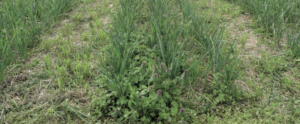
Figure 8.6. Mowed wheat (Triticum aestivum) living mulch in between onion crop rows provides a mulch mat on the soil surface to suppress winter annual weeds, such as the blooming purple deadnettle weeds in foreground.
The presence of living mulches in row middles also helps to suppress many weeds.
In one study, when hairy vetch and rye living mulch residues covered at least 90 percent of the soil, weed density was decreased by 78 percent.21
Examples of species that can be used as both weed-suppressive cover crops or carefully managed living mulches include:
Red clover (Trifolium pratense) is adapted to cooler areas; plant in fall, spring, or early summer. It needs to be kept mowed as a living mulch to set it back so that it does not compete with crops.
Red clover can be competitive as a living mulch if it’s not stressed a bit by mowing.
Mustards (Brassica spp.) release biochemicals that suppress germinating weeds temporarily when mowed or tilled in. (They can also inhibit small-seeded vegetable crops, like lettuce, from germinating.)
Annual ryegrass (Lolium multiflorum) germinates and grows quickly. If planted as a living mulch, don’t allow it to go to seed; mow or till it before it seeds.
Perennial ryegrass (Lolium perenne) is adapted to cooler areas and can be planted in either fall or spring. It can be challenging to manage because it is so vigorous and can grow tall as a living mulch. In small garden spaces, mow it regularly to keep it from taking over.
Annual wheat (Triticum aestivum) and winter cereal rye (Secale cereale) are both good weed-suppressing cover crops and living mulches. Wheat does not produce as much biomass as cereal rye, but it can be a good cover crop for smaller garden spaces. Rye may also have an allelopathic effect. However, managing rye as a living mulch can be challenging because it is so vigorous.
Notes
14. Matt Liebman and Adam S. Davis, “Managing Weeds in Organic Farming Systems: An Ecological Approach,” in Organic Farming: The Ecological System, vol. 54, Agronomy Monographs, ed. Charles Francis (Madison: American Society of Agronomy, 2009): 173–96, https://doi.org/10.2134/agronmonogr54.c8.
15. Elizabeth Dyck, Matt Liebman, and M. S. Erich, “Crop-Weed Interference as Influenced by a Legumi- nous or Synthetic Fertilizer Nitrogen Source: II. Rotation Experiments with Crimson Clover, Field Corn, and Lambsquarters,” Agriculture, Ecosystems & Environment 56, no. 2 (1995): 109–20, https://doi.org/10.1016/0167-8809(95)00644 -3.
16. Yvonne E. Lawley, John R. Teasdale, and Ray R. Weil, “The Mechanism for Weed Suppression by a Forage Radish Cover Crop,” Agronomy Journal 104, no. 2 (2012): 205–14, https://doi.org/10.2134/agronj2011.0128.
17. Marianne Sarrantonio and Eric R. Gallandt, “The Role of Cover Crops in North American Cropping Systems,” Journal of Crop Production 8 (2003): 53–74, https://doi.org/10.1300/J144v08n01_04.
18. Nancy G. Creamer, Mark A. Bennett, and Benjamin R. Stinner, “Evaluation of Cover Crop Mixtures for Use in Vegetable Production Systems,” HortScience 32, no. 5 (1997): 866–70, https://doi.org/10.21273 /HORTSCI.32.5.866.
19. T. Ohno et al., “Phytotoxic Effects of Red Clover Amended Soils on Wild Mustard Seedling Growth,” Agriculture, Ecosystems & Environment 78, no. 2 (2000): 187–92, https://doi.org/10.1016/S0167-8809(99)00120-6.
20. C. L. Mohler et al., “Reduction in Weed Seedling Emergence by Pathogens Following the Incorporation of Green Crop Residue,” Weed Research 52, no. 5 (2012): 467–77, https://doi.org/10.1111/j.1365-3180.2012.00940.x.
21. John R. Teasdale, “Contribution of Cover Crops to Weed Management in Sustainable Agricultural Systems,” Journal of Production Agriculture 9, no. 4 (1996): 475–79, https://doi.org/10.2134/jpa1996.0475.
Recommended Reads
How to Grow Healthy Plants: Strengthening Your Farm or Garden’s Immune System
Recent Articles
Garden strawberries are excellent for both covering the ground and for growing fruit. If you’re planning out a forest garden, or are just looking for a plant to use as ground cover, strawberries are a great option. The following is an excerpt from The Home-Scale Forest Garden by Dani Baker. It has been adapted for…
Read MoreAsparagus is a delicious vegetable with a layered history. How did this aspiring spear make its way from growing in the wild to appearing on our plates? The following is an excerpt from the The Seed Detective by Adam Alexander. It has been adapted for the web. “Nature gives us the key to every secret…
Read MoreInterested in growing trees? Here are some tips on successfully planting, transplanting, and pruning trees to create a flourishing forest garden! The following is an excerpt from The Home-Scale Forest Garden by Dani Baker. It has been adapted for the web. Planting Potted Trees and Shrubs If you order potted trees, check with your supplier to…
Read MoreWith the right strategies and practices, composting on a small farm is surprisingly easy and inexpensive. Just follow these steps for making compost, and your farm will be thriving in no time! The following excerpt is from The Lean Farm Guide to Growing Vegetables by Ben Hartman. It has been adapted for the web. (All photographs by Ben…
Read MoreGarlic mustard: while known as “invasive,” this plant can be consumed in its entirety and has great nutritional value. Plus, the garlic-flavor is a perfect addition to any recipe that calls for mustard! The following are excerpts from Beyond the War on Invasive Species by Tao Orion and The Wild Wisdom of Weeds by Katrina…
Read More

